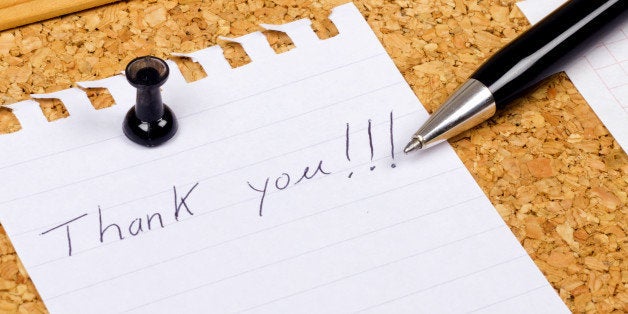
It is astonishing how quickly we adapt to the good things in life. A famous example of this is lottery winners. In the short term, their happiness shoots up dramatically but over the long term they are not significantly happier than non-winners.
The truth is we get used to nice things. Consider WiFi, air conditioning, cappuccinos, and eating fresh oranges in the middle of winter. Not so long ago they were considered luxuries. Today they are "normal."
One strategy to counteract taking things for granted is to cultivate gratitude. The benefits of gratitude abound. It is associated with stronger immune systems, lower blood pressure, greater optimism and happiness and more compassion.
Writing someone a letter is one of my favorite ways to cultivate gratitude. I try to write one every week--not just a generic "thank you" note but a personal letter expressing appreciation. Is there a secret recipe for writing a good letter? I don't think so. There are many creative ways to express gratitude. This is the blueprint I use:
Address and stamp the envelope first: Getting started is often the hardest part. As soon as I get this step out of the way, I can concentrate on the actual content of the letter and not worry about logistics. It is liberating.
Make it personal: Include details. I do my best to make it relevant and meaningful for the person I am writing to.
Use a pen: Even if someone's handwriting is messy, a handwritten note expresses so much more than a typed or emailed one. Putting pen to paper takes a different kind of effort. It is authentic and "not a cut-and-pasted, global searched-and-replaced bit of faux intimacy" as described by psychologist Chris Peterson.
Stationary is optional: I adore beautiful cards but they are not a requirement. A post card or a blank piece of paper work just as well. It is the thought that counts. When I was an intern, a patient once wrote me a beautiful thank you note on the back of a paper towel. It lived in the pocket of my white coat for months. Just knowing it was there provided me with strength and courage.
Take time: I consider what I want to say beforehand and give myself time to write it. Part of the beauty of writing a letter is that it forces me to slow down.
Give it your full attention: Chris Peterson says it best:
The thing about writing a letter is that no one can multitask while doing so, unlike e-mails or telephone calls. A letter represents undivided attention and is precious as a consequence.
Both writing and receiving a handwritten note has a boosting effect. Whenever I receive one, I pin it on what I call my Gratitude Wall. For me, it is a kaleidoscope of goodness and an embodiment of connection and meaning. Knowing someone has taken the time and made the effort to hand write me a note fills me with gratitude and inspires me to do the same
Two thousand years ago, Cicero said:
Gratitude is not only the greatest of virtues, but the parent of all others.
Gratitude is something that only finds meaning when it is expressed. Express it this holiday season and whenever you can.
For science-backed, actionable insights delivered directly to your inbox, visit www.PositivePrescription.com and sign-up for The Weekly Dose